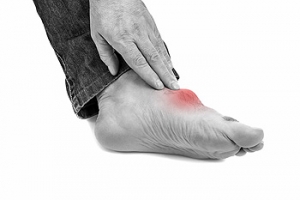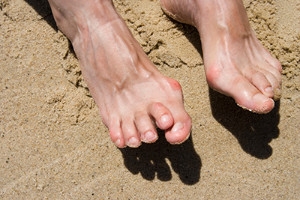
Why Does the Skin on My Heels Feel Uncomfortable?
 Excessively dry skin on the heels may lead to a condition that is known as heel fissures. Heel fissures are defined as deep cracks in the skin of the heels, which can cause quite a deal of pain. There are a variety of reasons why this ailment may occur. These can include sudden weight gain, wearing shoes that have an open back, or medical conditions such as eczema or psoriasis. Patients may find relief in mild cases when the affected area is moisturized several times per day, and if a pumice stone is used to remove any dead skin. In severe cases of cracked heels, it is suggested that you meet with a podiatrist who can properly trim skin that has become thick and callused, in addition to prescribing medication that may help to heal this ailment.
Excessively dry skin on the heels may lead to a condition that is known as heel fissures. Heel fissures are defined as deep cracks in the skin of the heels, which can cause quite a deal of pain. There are a variety of reasons why this ailment may occur. These can include sudden weight gain, wearing shoes that have an open back, or medical conditions such as eczema or psoriasis. Patients may find relief in mild cases when the affected area is moisturized several times per day, and if a pumice stone is used to remove any dead skin. In severe cases of cracked heels, it is suggested that you meet with a podiatrist who can properly trim skin that has become thick and callused, in addition to prescribing medication that may help to heal this ailment.
If the skin on your feet starts to crack, you may want to see a podiatrist to find treatment. If you have any concerns, contact one of our podiatrists from Princeton Foot and Ankle Associates. Our doctors can provide the care you need to keep you pain-free and on your feet.
Cracked Heels
It is important to moisturize your cracked heels in order to prevent pain, bleeding, and infection. The reason cracked heels form is because the skin on the foot is too dry to support the immense pressure placed on them. When the foot expands, the dry skin on the foot begins to split.
Ways to Help Heal Them
- Invest in a good foot cream
- Try Using Petroleum Jelly
- Ease up on Soaps
- Drink Plenty of Water
Ways to Prevent Cracked Heels
- Moisturize After Showering
- Skip a Shower
- Keep Shower Water Lukewarm
- Don’t Scrub Your Feet
If you are unsure how to proceed in treating cracked heels, seek guidance from a podiatrist. Your doctor will help you with any questions or information you may need.
If you have any questions, please feel free to contact our offices located in Princeton, and West Windsor, NJ . We offer the newest diagnostic and treatment technologies for all your foot care needs.
Solutions for Cracked Heels
Cracked heels can make life very frustrating and embarrassing when displaying the bare feet. Aside from being unpleasing to the eye, they can also tear stockings and socks and wear out shoes at a faster rate. When severe, cracked heels may cause pain or infection.
Cracked heels are a problem for those who are athletic, those who may walk a lot, and those who have especially dry skin. Those who use medication that dry the skin, those who swim often, wearing certain types of shoes, and those who are diabetic may have trouble with cracked heels. Seniors whose skin produces less oil may also have trouble with cracked feet. There is no one way to develop cracked feet, and there is no cure.
Today, the market consists of numerous products that have a variety of ingredients to promote healing. Some of these are over-the-counter. Others are prescribed by a doctor, especially for those who have chronic dry feet and heels.
Some doctors recommend wearing socks at night for those with rough skin. This helps further healing, and helps creams stay on longer and better absorb into the skin.
One way to alleviate dryness that causes cracked heels is by using moisturizers both day and night. Another way is to make sure the skin is clean and dry at all times. Using a pumice stone to buff away dead skin before putting on moisturizer can also help. Cracked heels will not respond to the cream unless the outer layer of skin is first removed through exfoliation. After exfoliation, lotion or ointment will be absorbed by the skin more easily.
Foods that produce healing and balance can also help the skin from within. Everything that is put into the body can either help it or hurt it. Taking supplements of omega-3 fatty acids and zinc can also be very beneficial.
Nevertheless, not all products are guaranteed to help treat cracked feet. Seeing a professional is best if other treatments options were unsuccessful. A podiatrist should be able to give the best advice to help with this problem.
What is Gout?
 A large amount of uric acid in the body may lead to a condition that is commonly known as gout. This ailment often produces severe pain and discomfort, and typically affects the big toe. Patients who are afflicted with gout may notice the pain is so debilitating, it may cause an inability to walk. Additional symptoms may include redness, swelling, and some patients may have a fever. Gout is caused by factors that can include family history, and from eating foods that have elevated purine levels. This can lead to a build-up of uric acid, which may cause sharp pains between the joints in the big toe. These types of foods can consist of shellfish, red meat, and drinks that have a high sugar content. Mild relief may be found when the affected foot is elevated, and this may help to diminish a portion of the swelling as well. If you have developed gout, it is strongly advised that you consult with a podiatrist who can help you to find comfort, and suggest methods to possibly prevent this ailment from occurring in the future.
A large amount of uric acid in the body may lead to a condition that is commonly known as gout. This ailment often produces severe pain and discomfort, and typically affects the big toe. Patients who are afflicted with gout may notice the pain is so debilitating, it may cause an inability to walk. Additional symptoms may include redness, swelling, and some patients may have a fever. Gout is caused by factors that can include family history, and from eating foods that have elevated purine levels. This can lead to a build-up of uric acid, which may cause sharp pains between the joints in the big toe. These types of foods can consist of shellfish, red meat, and drinks that have a high sugar content. Mild relief may be found when the affected foot is elevated, and this may help to diminish a portion of the swelling as well. If you have developed gout, it is strongly advised that you consult with a podiatrist who can help you to find comfort, and suggest methods to possibly prevent this ailment from occurring in the future.
Gout is a foot condition that requires certain treatment and care. If you are seeking treatment, contact one of our podiatrists from Princeton Foot and Ankle Associates. Our doctors will treat your foot and ankle needs.
What Is Gout?
Gout is a type of arthritis caused by a buildup of uric acid in the bloodstream. It often develops in the foot, especially the big toe area, although it can manifest in other parts of the body as well. Gout can make walking and standing very painful and is especially common in diabetics and the obese.
People typically get gout because of a poor diet. Genetic predisposition is also a factor. The children of parents who have had gout frequently have a chance of developing it themselves.
Gout can easily be identified by redness and inflammation of the big toe and the surrounding areas of the foot. Other symptoms include extreme fatigue, joint pain, and running high fevers. Sometimes corticosteroid drugs can be prescribed to treat gout, but the best way to combat this disease is to get more exercise and eat a better diet.
If you have any questions please feel free to contact our offices located in Princeton, and West Windsor, NJ . We offer the newest diagnostic and treatment technologies for all your foot and ankle needs.
Everything You Need to Know About Gout
Gout, typically found in diabetic patients, is an unusually painful form of arthritis caused by elevated levels of uric acid in the bloodstream. The condition typically strikes the big joint on the big toe. It has also been known to strike the knees, elbows, fingers, ankles and wrists—generally anywhere that has a functioning, moving joint.
The high level of uric acid in a person’s bloodstream creates the condition known as hyperuricema—the main cause of gout. Genetic predisposition occurs in nine out of ten sufferers. The children of parents who suffer gout will have a two in ten chance of developing the condition as well.
This form of arthritis, being particularly painful, is the leftover uric acid crystallizing in the blood stream. The crystallized uric acid then travels to the space between joints where they rub, causing friction when the patient moves. Symptoms include: pain, redness, swelling, and inflammation. Additional side effects may include fatigue and fever, although reports of these effects are very rare. Some patients have reported that pain may intensify when the temperature drops, such as when you sleep.
Most cases of gout are easily diagnosed by a podiatrist’s assessment of the various symptoms. Defined tests can also be performed. A blood test to detect elevated levels of uric acid is often used as well as an x-ray to diagnose visible and chronic gout.
Treatment for gout simply means eliminating symptoms. Non-steroid anti-inflammatory drugs or NSAIDs (Colchicine and other corticosteroid drugs, etc.) will quell the redness, the swelling, and the inflammation. However, managing your diet, lifestyle changes, and using preventative drugs are all helpful toward fully combating the most severe cases.
Those that lead an inactive lifestyle are at a higher risk for gout. Any amount of exercise decreases the probability of repeat encounters with the condition. Reducing your consumption of red meat, sea food, and fructose-sweetened drinks also reduces the likelihood of chronic gout as well.
Ingesting Vitamin C, coffee, and particular dairy products can help with maintaining a healthy lifestyle. There are new drugs out on the market that inhibit the body’s production of uric acid-producing enzymes. However, reducing or eliminating your overall levels of uric acid is the best remedy to ensuring you lead a gout-free life.
Why Are My Feet Swollen During My Pregnancy?
 Many pregnant women are aware of the changes that happen to their feet and ankles. This is generally a result of increased blood volume, and additional weight that is caused by the growing baby. The feet and ankles may become swollen, which is why it may be beneficial for women to purchase larger shoes. Mild relief may be found when the legs are elevated, and it may help to limit the amount of time walking and standing throughout the day. Additionally, it may be beneficial to drink plenty of water daily, and to place a cold compress on your ankles. If you are afflicted with swollen ankles and feet during your pregnancy, it is strongly suggested that you seek the counsel of a podiatrist who can address any foot concerns you may have.
Many pregnant women are aware of the changes that happen to their feet and ankles. This is generally a result of increased blood volume, and additional weight that is caused by the growing baby. The feet and ankles may become swollen, which is why it may be beneficial for women to purchase larger shoes. Mild relief may be found when the legs are elevated, and it may help to limit the amount of time walking and standing throughout the day. Additionally, it may be beneficial to drink plenty of water daily, and to place a cold compress on your ankles. If you are afflicted with swollen ankles and feet during your pregnancy, it is strongly suggested that you seek the counsel of a podiatrist who can address any foot concerns you may have.
Pregnant women with swollen feet can be treated with a variety of different methods that are readily available. For more information about other cures for swollen feet during pregnancy, consult with one of our podiatrists from Princeton Foot and Ankle Associates. Our doctors will attend to all of your foot and ankle needs.
What Foot Problems Can Arise During Pregnancy?
One problem that can occur is overpronation, which occurs when the arch of the foot flattens and tends to roll inward. This can cause pain and discomfort in your heels while you’re walking or even just standing up, trying to support your baby.
Another problem is edema, or swelling in the extremities. This often affects the feet during pregnancy but tends to occur in the later stages.
How Can I Keep My Feet Healthy During Pregnancy?
- Wearing orthotics can provide extra support for the feet and help distribute weight evenly
- Minimize the amount of time spent walking barefoot
- Wear shoes with good arch support
- Wear shoes that allow for good circulation to the feet
- Elevate feet if you experience swelling
- Massage your feet
- Get regular, light exercise, such as walking, to promote blood circulation to the feet
If you have any questions please feel free to contact our offices located in Princeton, and West Windsor, NJ . We offer the newest diagnostic and treatment technologies for all your foot and ankle needs.
Foot Care for Pregnant Women
The natural weight that pregnant women gain causes their center of gravity to be completely altered. This causes them to have a new weight-bearing stance which adds pressure to the knees and feet. As a result, pregnant women often experience severe foot pain. The two most common foot issues experienced by women in their pregnancies are edema and over-pronation. It is important for all pregnant women to learn more about how to take care of their feet so they are more comfortable during their pregnancy.
Over-pronation, which is commonly referred to as flat feet, is caused when a person’s arch flattens out upon weight bearing. This causes the person’s feet to roll inward while walking. Pregnant women often experience this due to the sudden weight they gain.
Edema, also referred as swelling in the feet, typically occurs in the later part of the pregnancy. It is the result of the extra blood accumulated in the pregnant woman’s body. The enlarged uterus puts more pressure on the blood vessels in the pelvis which causes leg circulation to slow down. This causes blood to pool in the lower extremities.
Fortunately, there are ways to treat both edema and over-pronation. Edema can be treated by elevating the foot as often as possible. Wearing proper fitting footwear will also be helpful for those with edema. A treatment method for over-pronation could be orthotics. Orthotic inserts should be designed with appropriate arch support and medial rear foot for your foot.
It is best for pregnant women to buy new shoes during the day, because this is the time where swelling is at its peak. Pregnant women also shouldn’t rush when buying shoes. It is always advised that you make sure your shoes fit properly but this is especially important during pregnancy.
If you are a pregnant woman, you should consult with a podiatrist in order to make sure your feet are healthy throughout the entirety of your pregnancy.
Ballet Dancers and Stress Fractures
 A hairline crack in the bones of the foot is generally considered to be a stress fracture. This can be a common ailment among ballet dancers, and may heal faster when it is diagnosed early. Stress fractures may happen as a result of performing dances that have repeated jumping and running routines, however, stress fractures may not be immediately recognized. There can be existing conditions which can significantly increase the possibility of developing a stress fracture. These can include having flat feet or excessively high arches. Additionally, wearing shoes that do not fit correctly, or dancing for several hours at a time, may lead to a stress fracture. If you feel you have this condition, please consult with a podiatrist who can help you to manage this ailment.
A hairline crack in the bones of the foot is generally considered to be a stress fracture. This can be a common ailment among ballet dancers, and may heal faster when it is diagnosed early. Stress fractures may happen as a result of performing dances that have repeated jumping and running routines, however, stress fractures may not be immediately recognized. There can be existing conditions which can significantly increase the possibility of developing a stress fracture. These can include having flat feet or excessively high arches. Additionally, wearing shoes that do not fit correctly, or dancing for several hours at a time, may lead to a stress fracture. If you feel you have this condition, please consult with a podiatrist who can help you to manage this ailment.
Stress fractures occur when there is a tiny crack within a bone. To learn more, contact one of our podiatrists from Princeton Foot and Ankle Associates. Our doctors can provide the care you need to keep you pain free and on your feet.
How Are They Caused?
Stress fractures are the result of repetitive force being placed on the bone. Since the lower leg and feet often carry most of the body’s weight, stress fractures are likely to occur in these areas. If you rush into a new exercise, you are more likely to develop a stress fracture since you are starting too much, too soon. Pain resulting from stress fractures may go unnoticed at first, however it may start to worsen over time.
Risk Factors
- Gender – They are more commonly found in women compared to men.
- Foot Problems – People with unusual arches in their feet are more likely to develop stress fractures.
- Certain Sports – Dancers, gymnasts, tennis players, runners, and basketball players are more likely to develop stress fractures.
- Lack of Nutrients – A lack of vitamin D and calcium may weaken the bones and make you more prone to stress fractures
- Weak Bones – Osteoporosis can weaken the bones therefore resulting in stress fractures
Stress fractures do not always heal properly, so it is important that you seek help from a podiatrist if you suspect you may have one. Ignoring your stress fracture may cause it to worsen, and you may develop chronic pain as well as additional fractures.
If you have any questions, please feel free to contact our offices located in Princeton, and West Windsor, NJ . We offer the newest diagnostic and treatment technologies for all your foot care needs.
Stress Fractures of the Foot and Ankle
Our bones are important aspects of our body and they are constantly changing. The heavier the workload for a bone, the more likely it is that calcium will be placed in it. When a bone isn’t used often, there won’t be much calcium within it. When stress from repetitive loads prevent the bone from being able to repair itself, cracks will start to form. Stress fractures are defined as cracks in a bone that result from repetitive force, such as overuse.
The most common cause of stress fractures is a sudden increase in intensity and duration of physical activity. For example, if you begin to run long distances without working your way into doing so, you will be more likely to develop a stress fracture.
Common symptoms of stress fractures are pain and swelling near the weight bearing area on the injured bone. When initial x-rays are performed, it is possible that the fracture will not show up. However, once the stress on the area continues, the damage will increase, and the fracture will be severe enough to show up on an x-ray. Certain parts of the foot are more likely to develop stress fractures than others. Areas that typically have these fractures are: the metatarsals, the navicular bone, the calcaneus, tibia, and fibula.
Since women are at an increased risk of developing osteoporosis, they are twice as likely as men to sustain a stress fracture. Additionally, old age causes a decrease in bone mineral density which is why elderly people are also likely to develop these fractures.
It is important for you to be professionally diagnosed by a podiatrist if you suspect you have a stress fracture, because there are other injuries that can easily be mistaken for a fracture. Sprains, strains, shin splints, plantar fasciitis, and Morton’s neuroma can all easily be mistaken for stress fractures in the foot. Your podiatrist will likely ask you a series of questions to determine what type of pain you are experiencing. These questions will help your doctor identify whether you have a stress fracture.
The best method of treatment for a stress fracture is rest. Additionally, a walking boot, cast, or crutches, will help rest the area that is injured. The typical healing time for stress fractures is 4-12 weeks, however this depends on which bone is involved.
What Toes Does Hammertoe Affect?
The medical condition that is known as hammertoe is considered to be a deformity in the middle joint of the second toe. It may gradually bend to resemble a hammer, and can overlap onto the third toe. There are a variety of reasons why this condition may occur. These can include wearing shoes that do not have adequate room for the toes to move freely in, genetic factors that may involve a muscle imbalance, or from a toe injury. Common symptoms that are often associated with hammertoe can consist of redness and swelling on the affected joint, pain while wearing shoes, and it can be difficult to move the affected toe. It may be helpful to wear shoes that are a larger size, in addition using insoles which may relieve a portion of the discomfort. If you are afflicted with hammertoe, it is suggested that you schedule an appointment with a podiatrist who can offer correct treatment options.
Hammertoe
Hammertoes can be a painful condition to live with. For more information, contact one of our podiatrists from Princeton Foot and Ankle Associates. Our doctors will answer any of your foot- and ankle-related questions.
Hammertoe is a foot deformity that affects the joints of the second, third, fourth, or fifth toes of your feet. It is a painful foot condition in which these toes curl and arch up, which can often lead to pain when wearing footwear.
Symptoms
- Pain in the affected toes
- Development of corns or calluses due to friction
- Inflammation
- Redness
- Contracture of the toes
Causes
Genetics – People who are genetically predisposed to hammertoe are often more susceptible
Arthritis – Because arthritis affects the joints in your toes, further deformities stemming from arthritis can occur
Trauma – Direct trauma to the toes could potentially lead to hammertoe
Ill-fitting shoes – Undue pressure on the front of the toes from ill-fitting shoes can potentially lead to the development of hammertoe
Treatment
Orthotics – Custom made inserts can be used to help relieve pressure placed on the toes and therefore relieve some of the pain associated with it
Medications – Oral medications such as anti-inflammatories or NSAIDs could be used to treat the pain and inflammation hammertoes causes. Injections of corticosteroids are also sometimes used
Surgery – In more severe cases where the hammertoes have become more rigid, foot surgery is a potential option
If you have any questions please contact our offices located in Princeton, and West Windsor, NJ . We offer the newest diagnostic and treatment technologies for all your foot and ankle needs.








